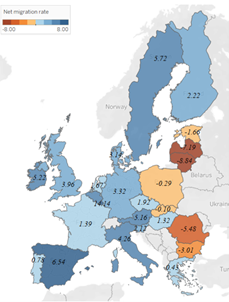European Migration Trends in 2022 Show Divergence Based on WWII History

A recent social media post has drawn attention to a notable pattern in Europe's 2022 migration rates, suggesting a correlation between a nation's World War II history and its current demographic shifts. The tweet, from user @guineboud_en, highlighted that three of Europe's most heavily World War II-ravaged countries recorded some of the lowest net migration rates in 2022, while two historically neutral nations topped the list.
"@pegobry_en @Anarseldain 3 of the most WW2-ravaged countries in Europe, at the bottom of West Europe's migration rates in 2022. The top 2? Neutral in WW2. https://t.co/azhh91Empm," the tweet stated.
According to Eurostat data for 2022, Ireland registered the highest crude rate of net migration within the European Union, at +32.9 per 1,000 inhabitants. Portugal followed closely among the top performers with a rate of +21.0 per 1,000 inhabitants. Both Ireland and Portugal maintained neutrality throughout World War II.
Conversely, countries with significant World War II devastation recorded some of the lowest net migration rates. Bulgaria and Latvia both reported a crude net migration rate of +0.1 per 1,000 inhabitants, while Slovakia registered +0.5 per 1,000 inhabitants. These nations experienced extensive conflict, occupation, and profound societal disruption during the war.
This pattern suggests a potential long-term demographic impact stemming from historical events. While the tweet points to a striking observation, migration patterns are influenced by a complex interplay of economic, social, and political factors, including post-war recovery, economic development, and contemporary policies. The 2022 figures reflect a broader trend where the EU's crude rate of net migration rose to +8.0 per 1,000 inhabitants, a significant increase from previous years.